Get free scan and check if your device is infected.
Remove it nowTo use full-featured product, you have to purchase a license for Combo Cleaner. Seven days free trial available. Combo Cleaner is owned and operated by RCS LT, the parent company of PCRisk.com.
What is AT&T Email Virus?
Similar to FedEx Tracking Email Virus and eFax Email Virus, "AT&T Email Virus" is a spam email campaign that distributes the Hancitor trojan. Scammers send thousands of emails by presenting them as invoices and encouraging users to open attached Microsoft Office documents. Note that the documents are malicious and download and install Hancitor onto systems.
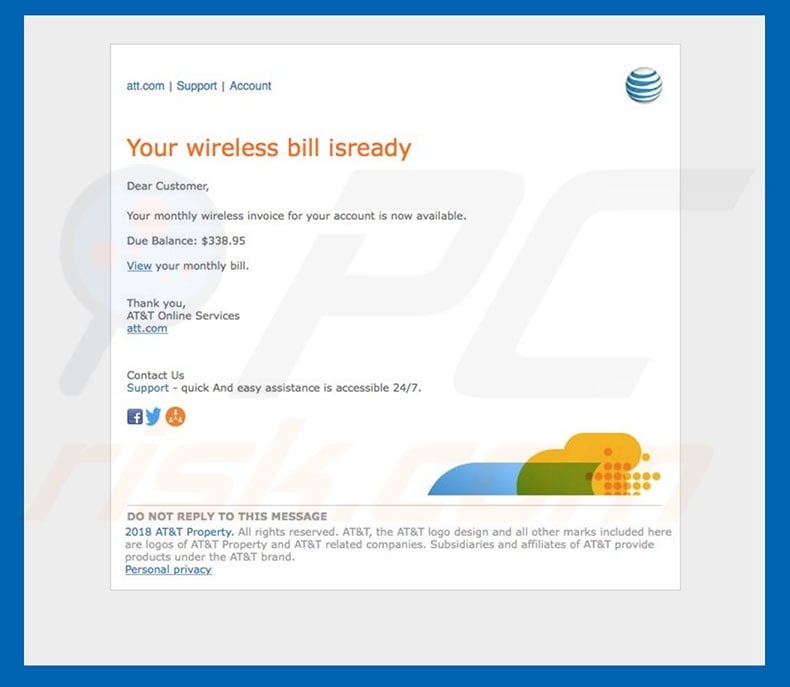
"AT&T Email Virus" campaign emails are presented as invoices from the AT&T company for wireless network services. Users must supposedly pay a certain sum of money, and for detailed information, must read the attached document. This is a scam. The opened file immediately downloads and installs malware.
Be aware that AT&T is a legitimate company and has nothing to do with this spam campaign. It is very common for cyber criminals to hide behind the names of governmental agencies and legitimate companies. They do this to trick users into opening attachments - people are much more likely to open files received from familiar names.
Hancitor is a high-risk virus designed to open "backdoors" for other malware (such as Pony) to infiltrate the system. The behavior of distributed viruses often differs. Depending on the virus, they might gather information, encrypt data, lock the computer, misuse system resources to mine cryptocurrencies, cause redirects to malicious websites, and so on.
These chain infections can lead to significant financial/data losses and even identity theft. If you have recently opened "AT&T Email Virus" campaign attachments, there is a high probability that your computer is infected with the Hancitor trojan. Therefore, you should immediately scan it with a legitimate anti-spyware/anti-virus program and remove all detected threats.
| Name | AT&T Invoice spam |
| Threat Type | Trojan, Password stealing virus, Banking malware, Spyware |
| Symptoms | Trojans are designed to stealthily infiltrate victim's computer and remain silent thus no particular symptoms are clearly visible on an infected machine. |
| Distribution methods | Infected email attachments, malicious online advertisements, social engineering, software cracks. |
| Damage | Stolen banking information, passwords, identity theft, victim's computer added to a botnet. |
| Malware Removal (Windows) |
To eliminate possible malware infections, scan your computer with legitimate antivirus software. Our security researchers recommend using Combo Cleaner. Download Combo CleanerTo use full-featured product, you have to purchase a license for Combo Cleaner. 7 days free trial available. Combo Cleaner is owned and operated by RCS LT, the parent company of PCRisk.com. |
There are many trojan-type viruses distributed using email spam campaigns. For example, TrickBot, FormBook, Adwind, and so on, however, unlike Hancitor, most of these trojans do not proliferate viruses.
As mentioned above, they gather sensitive information, such as saved logins/passwords, visited websites, etc. In any case, trojan-type viruses pose a significant threat to your privacy and Internet browsing safety. All must be eliminated immediately.
How did AT&T Email Virus infect my computer?
"AT&T Email Virus" proliferates a malicious Microsoft Office document. After opening this file, users are presented with a message stating that they must enable macro commands, otherwise the content will not be displayed properly. Enabling macros simply grants attachments permission to execute commands that stealthily download and install Hancitor into the system.
Although this distribution method is simple and effective, it has a major flaw. Malicious attachments are unable to download malware if the user opens them using applications that do not belong to the MS Office suite.
For example, if the .doc file is opened in an app other than Microsoft Word, the malware will not be downloaded. Furthermore, this spam campaign targets the Microsoft Windows operating system and users of other platforms are safe.
How to avoid installation of malware?
Lack of knowledge and careless behavior are the main reasons for computer infections. Caution is the key to safety. Therefore, pay attention when browsing the Internet and downloading/installing software. Carefully analyze all email attachments received. If the file seems suspicious/irrelevant and has been sent by a dubious email address, you should never open it.
Have a reputable anti-virus/anti-spyware suite installed and running. Note that newer versions (2010 and above) of MS Office were implemented with a feature that enables these programs to open newly-downloaded documents in "Protected View" mode. This prevents malicious attachments from infecting the system.
Therefore, using older versions of MS Office is not recommended. If you have already opened an "AT&T Email Virus" attachment, we recommend running a scan with Combo Cleaner Antivirus for Windows to automatically eliminate infiltrated malware.
Text presented in the "AT&T Email Virus" email message:
Subject: Your wireless invoice notification from AT&T
Your wireless bid is ready
Dear Customer,
Your monthly wireless invoice for your account in now available.
Due Balance: $338.95
View your monthly gill.
Thank you,
At&T online Services
att.com
Contact Us
Support - quick And easy assistance is accessible 24/7.
DO NOT REPLY TO THIS MESSAGE
2018 AT&T Property. All rights reserved. AT&T, the AT&T logo design and all other marks included here are logos of AT&T Property and AT&T related companies. Subsidiaries and affiliates of AT&T provide products under the AT&T brand.
Malicious attachment distributed via "AT&T Email Virus" spam campaign:
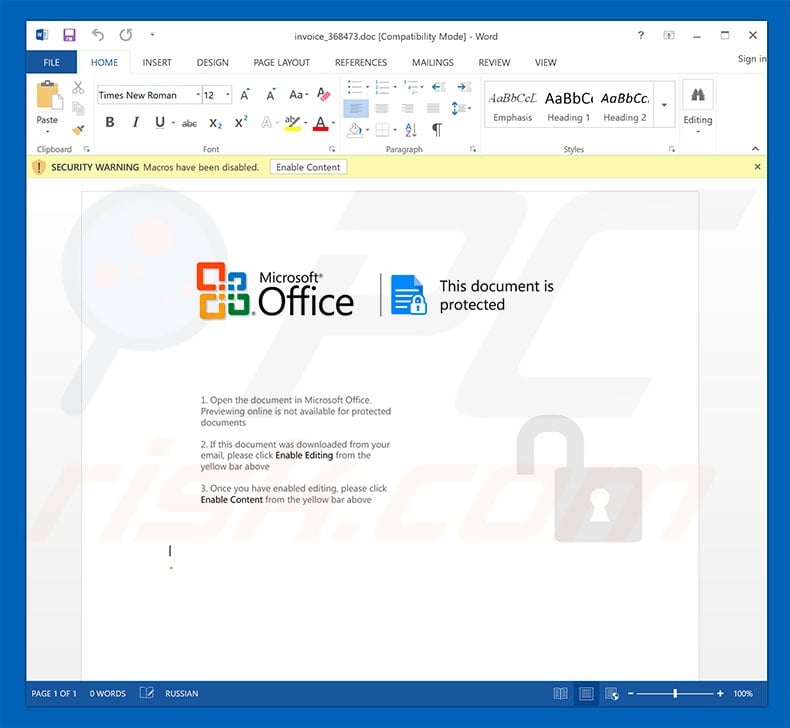
Hancitor trojan process ("Trainz") in Windows Task Manager:
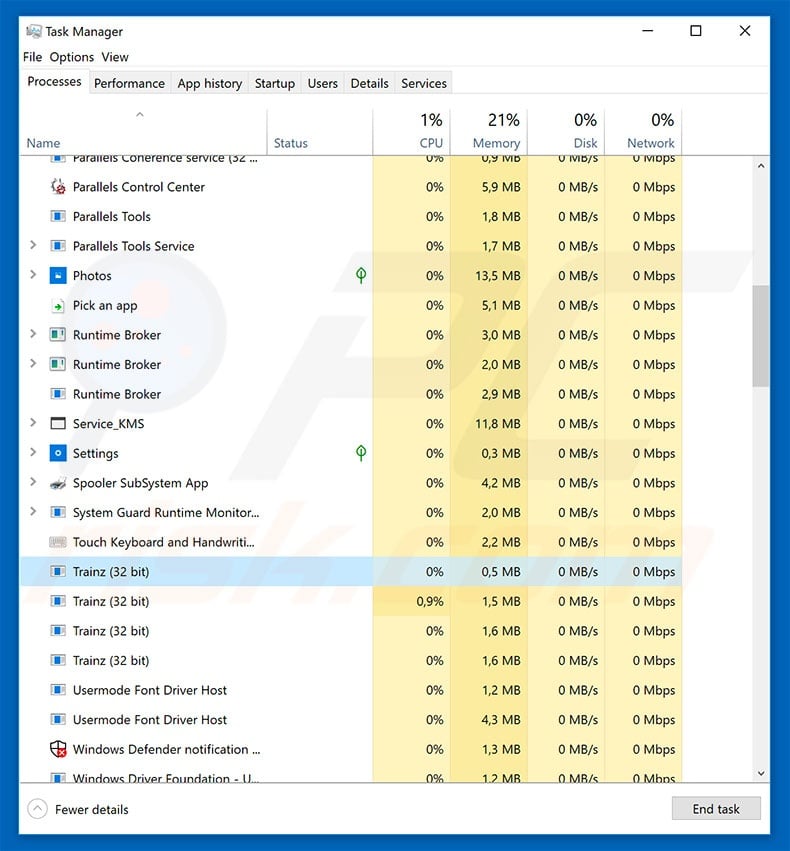
Other variants of AT&T Email Virus spam campaign letters that also distribute Hancitor trojan:
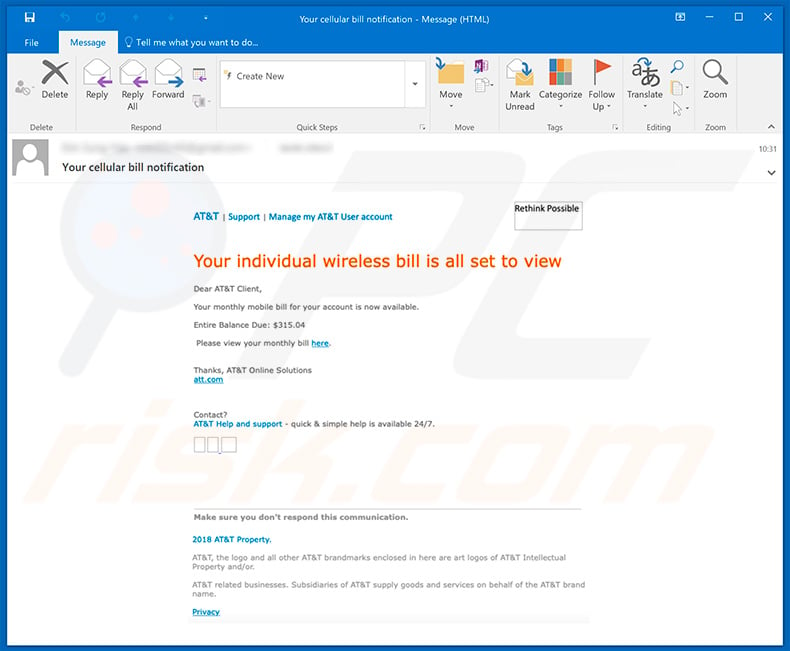
Text presented within this email:
Subject: Your cellular bill notification
AT&T | Support | My AT&T User Account
Your individual wireless bill is all set to view
Dear AT&T Client,
Your monthly mobile bill for your account is now available.
Entire Balance Due: $315.04
Please view your monthly bill here.
Thanks, AT&T Online Solutions
att.com
Contact?
AT&T Help and support - quick & simple help is available 24/7.
Make sure you don't respond to this communication.
2018 AT&T Property.
AT&T, the logo and all other AT&T brandmarks enclosed in here are art logos of AT&T Intellectual Property and/or.
AT&T related businesses. Subsidiaries of AT&T supply goods and services on behalf of the AT&T brand name.
Privacy
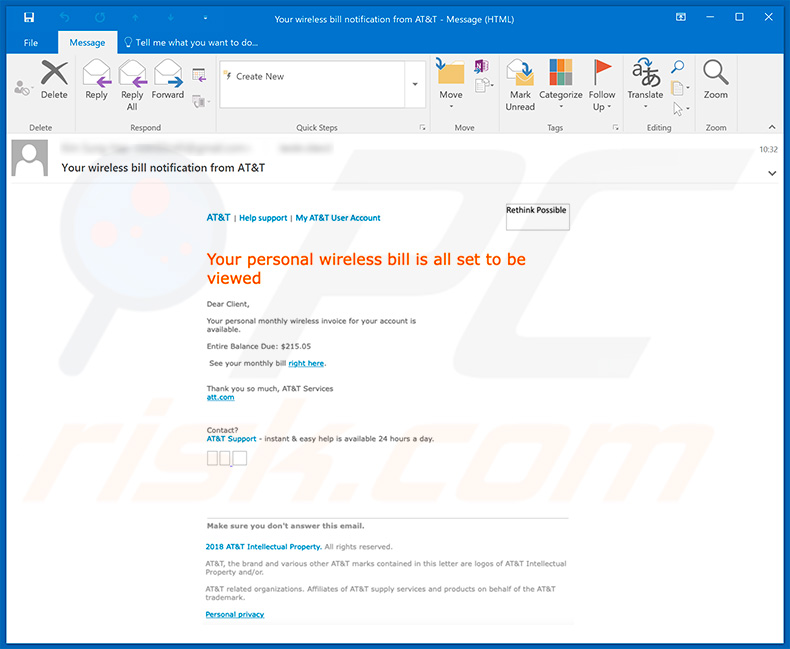
Text presented within this email:
Subject: Your wireless bill notification from AT&T
AT&T | Help support | Manage my AT&T User account
Your personal wireless bill is all set to be viewed
Dear Client,
Your personal monthly wireless invoice for your account is available.
Entire Balance Due: $215.05
See your monthly bill right here.
Thank you so much, AT&T Services
att.com
Contact?
AT&T Support - instant & easy help is available 24 hours a day.
Make sure you don't answer this email.
2018 AT&T Intellectual Property. All rights reserved.
AT&T, the brand and various other AT&T marks contained in this letter are logos of AT&T Intellectual Property and/or.
AT&T related organizations. Affiliates of AT&T supply services and products on behalf of the AT&T trademark.
Personal privacy
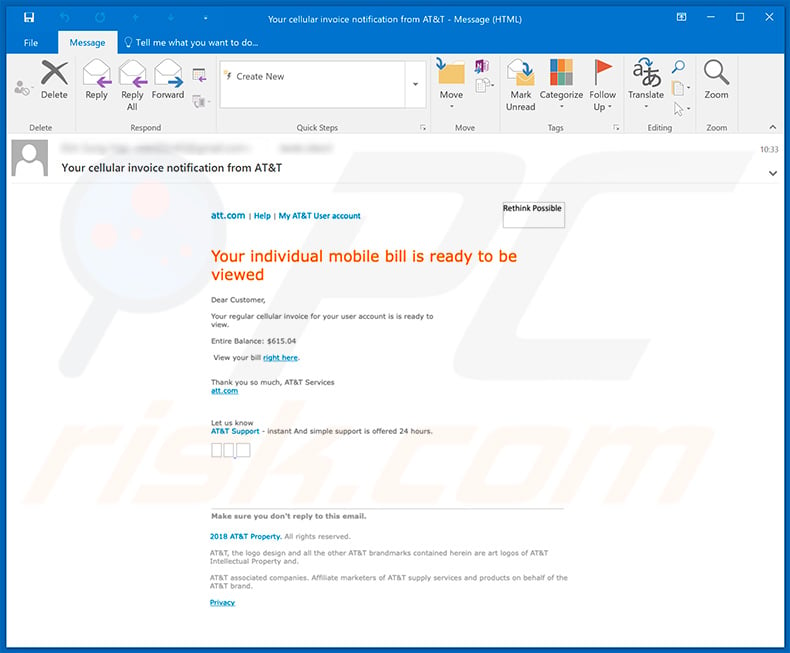
Text presented within this email:
Subject: Your cellular invoice notification from AT&T
att.com | Help | My AT&T User account
Your individual mobile bill is ready to be viewed
Dear Customer,
Your regular cellular invoice for your user account is is ready to view.
Entire Balance: $615.04
View your bill right here.
Thank you so much, AT&T Services
att.com
Let us know
AT&T support - instant And simple support is offered 24 hours.
Make sure you don't reply to this email.
2018 AT&T Property. All rights reserved.
AT&T, the logo design and all other AT&T brandmarks contained herein are art logos of AT&T Intellectual Property and.
AT&T associated companies. Affiliate marketers of AT&T supply services and products on behalf of the AT&T brand.
Privacy
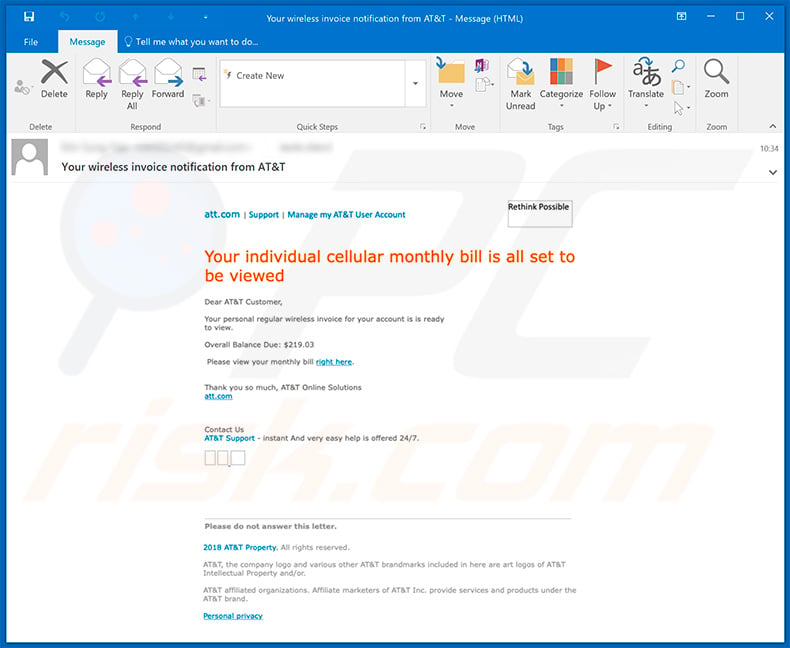
Text presented within this email:
Subject: Your wireless invoice notification from AT&T
att.com | Support | Manage my AT&T User account
Your individual cellular monthly bill is all set to be viewed
Dear AT&T Customer,
Your personal regular wireless invoice for your account is is ready to view.
Overall Balance Due: $219.03
Please view your monthly bill right here.
Thank you so much, AT&T Online Solutions
att.com
Contact Us
AT&T Support - instant and very easy help is offered 24/7.
Please do not answer this letter.
2018 AT&T Property. All rights reserved.
AT&T, the company logo and various other AT&T brandmarks included in here are art logos of AT&T Intellectual Property and/or.
AT&T affiliated organizations. Affiliate marketers of AT&T Inc. provide services and products under the AT&T brand.
Personal privacy
Update April 2nd, 2019 - AT&T email spam campaign has recently been used to promote phishing websites.
The email usually delivers a PDF document (at the time of research known PDF files were named "AT&T_Online_03_29_19.pdf", "AT&T_03_29_19.pdf" and "ATTBusiness_03_29_19.pdf") which contains some sort of payment information alongside with a link to a "payment confirmation website".
However, this link leads to a phishing site which asks users to enter various personal details which are then saved in a server controlled by cyber criminals. In other words, aside from spreading Hancitor trojan, crooks also use this spam campaign to steal personal data.
Example of a malicious PDF document ("ATTBusiness_03_29_19.pdf"):
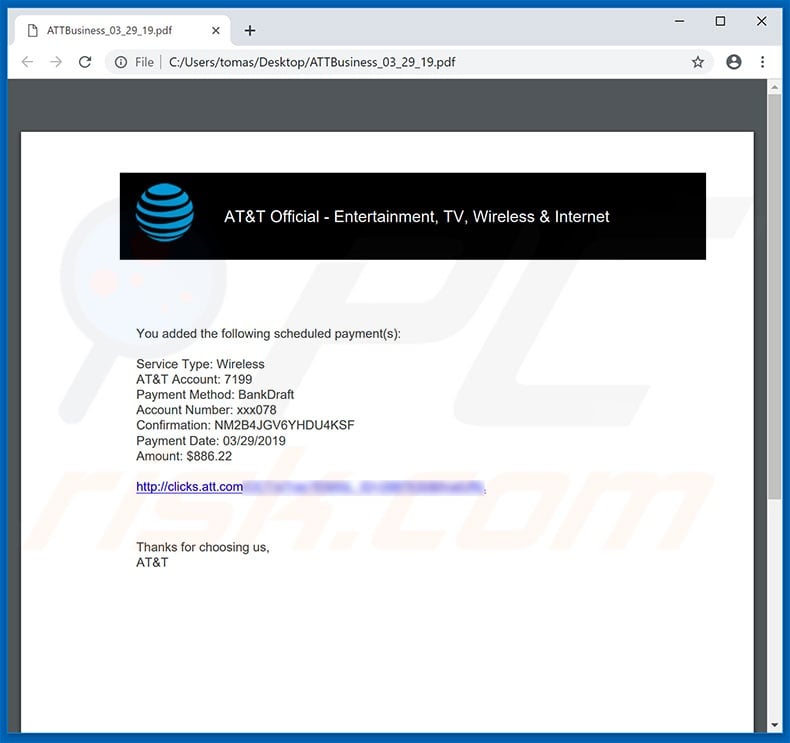
Text presented within this document:
You added the following scheduled payment(s):
Service Type: Wireless
AT&T Account: 7199
Payment Method: BankDraft
Account Number: xxx078
Confirmation: NM2B4JGV6YHDU4KSF
Payment Date: 03/29/2019
Amount: $886.22
hxxp://clicks.att.com/*************************
Thanks for choosing us,
AT&T
Malicious PDF document's technical analysis:
- Full list of antivirus detections: VirusTotal
- PDF file name: ATTBusiness_03_29_19.pdf
- Sample first submitted: 2019-03-29
AT&T email spam campaign spreading a malicious Microsoft Word attachment which injects Maze ransomware into the system:
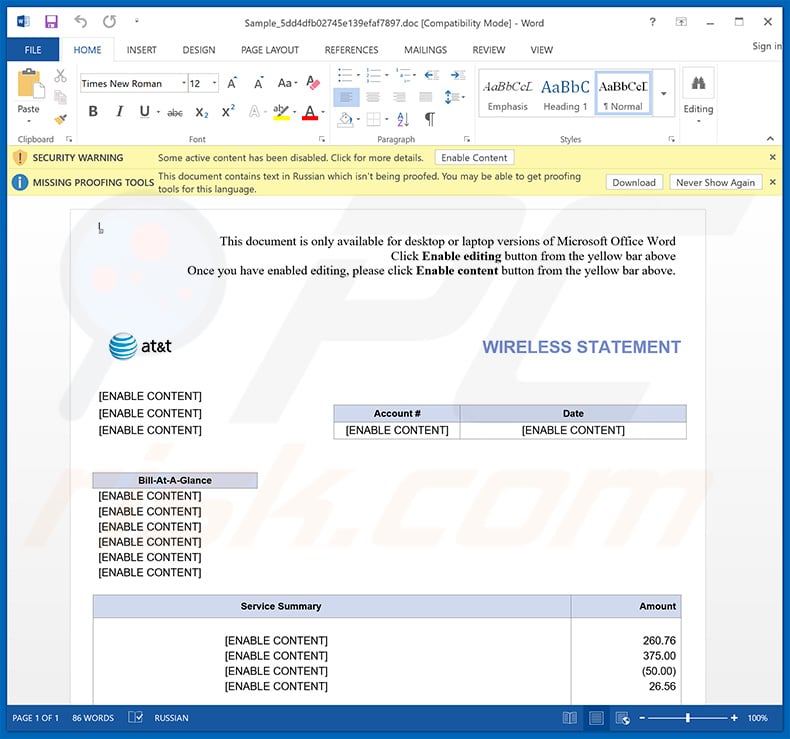
Instant automatic malware removal:
Manual threat removal might be a lengthy and complicated process that requires advanced IT skills. Combo Cleaner is a professional automatic malware removal tool that is recommended to get rid of malware. Download it by clicking the button below:
DOWNLOAD Combo CleanerBy downloading any software listed on this website you agree to our Privacy Policy and Terms of Use. To use full-featured product, you have to purchase a license for Combo Cleaner. 7 days free trial available. Combo Cleaner is owned and operated by RCS LT, the parent company of PCRisk.com.
Quick menu:
- What is AT&T Invoice spam?
- Types of malicious emails.
- How to spot a malicious email?
- What to do if you fell for an email scam?
Types of malicious emails:
![]() Phishing Emails
Phishing Emails
Most commonly, cybercriminals use deceptive emails to trick Internet users into giving away their sensitive private information, for example, login information for various online services, email accounts, or online banking information.
Such attacks are called phishing. In a phishing attack, cybercriminals usually send an email message with some popular service logo (for example, Microsoft, DHL, Amazon, Netflix), create urgency (wrong shipping address, expired password, etc.), and place a link which they hope their potential victims will click on.
After clicking the link presented in such email message, victims are redirected to a fake website that looks identical or extremely similar to the original one. Victims are then asked to enter their password, credit card details, or some other information that gets stolen by cybercriminals.
![]() Emails with Malicious Attachments
Emails with Malicious Attachments
Another popular attack vector is email spam with malicious attachments that infect users' computers with malware. Malicious attachments usually carry trojans that are capable of stealing passwords, banking information, and other sensitive information.
In such attacks, cybercriminals' main goal is to trick their potential victims into opening an infected email attachment. To achieve this goal, email messages usually talk about recently received invoices, faxes, or voice messages.
If a potential victim falls for the lure and opens the attachment, their computers get infected, and cybercriminals can collect a lot of sensitive information.
While it's a more complicated method to steal personal information (spam filters and antivirus programs usually detect such attempts), if successful, cybercriminals can get a much wider array of data and can collect information for a long period of time.
![]() Sextortion Emails
Sextortion Emails
This is a type of phishing. In this case, users receive an email claiming that a cybercriminal could access the webcam of the potential victim and has a video recording of one's masturbation.
To get rid of the video, victims are asked to pay a ransom (usually using Bitcoin or another cryptocurrency). Nevertheless, all of these claims are false - users who receive such emails should ignore and delete them.
How to spot a malicious email?
While cyber criminals try to make their lure emails look trustworthy, here are some things that you should look for when trying to spot a phishing email:
- Check the sender's ("from") email address: Hover your mouse over the "from" address and check if it's legitimate. For example, if you received an email from Microsoft, be sure to check if the email address is @microsoft.com and not something suspicious like @m1crosoft.com, @microsfot.com, @account-security-noreply.com, etc.
- Check for generic greetings: If the greeting in the email is "Dear user", "Dear @youremail.com", "Dear valued customer", this should raise suspiciousness. Most commonly, companies call you by your name. Lack of this information could signal a phishing attempt.
- Check the links in the email: Hover your mouse over the link presented in the email, if the link that appears seems suspicious, don't click it. For example, if you received an email from Microsoft and the link in the email shows that it will go to firebasestorage.googleapis.com/v0... you shouldn't trust it. It's best not to click any links in the emails but to visit the company website that sent you the email in the first place.
- Don't blindly trust email attachments: Most commonly, legitimate companies will ask you to log in to their website and to view any documents there; if you received an email with an attachment, it's a good idea to scan it with an antivirus application. Infected email attachments are a common attack vector used by cybercriminals.
To minimise the risk of opening phishing and malicious emails we recommend using Combo Cleaner Antivirus for Windows.
Example of a spam email:

What to do if you fell for an email scam?
- If you clicked on a link in a phishing email and entered your password - be sure to change your password as soon as possible. Usually, cybercriminals collect stolen credentials and then sell them to other groups that use them for malicious purposes. If you change your password in a timely manner, there's a chance that criminals won't have enough time to do any damage.
- If you entered your credit card information - contact your bank as soon as possible and explain the situation. There's a good chance that you will need to cancel your compromised credit card and get a new one.
- If you see any signs of identity theft - you should immediately contact the Federal Trade Commission. This institution will collect information about your situation and create a personal recovery plan.
- If you opened a malicious attachment - your computer is probably infected, you should scan it with a reputable antivirus application. For this purpose, we recommend using Combo Cleaner Antivirus for Windows.
- Help other Internet users - report phishing emails to Anti-Phishing Working Group, FBI’s Internet Crime Complaint Center, National Fraud Information Center and U.S. Department of Justice.
Share:

Tomas Meskauskas
Expert security researcher, professional malware analyst
I am passionate about computer security and technology. I have an experience of over 10 years working in various companies related to computer technical issue solving and Internet security. I have been working as an author and editor for pcrisk.com since 2010. Follow me on Twitter and LinkedIn to stay informed about the latest online security threats.
PCrisk security portal is brought by a company RCS LT.
Joined forces of security researchers help educate computer users about the latest online security threats. More information about the company RCS LT.
Our malware removal guides are free. However, if you want to support us you can send us a donation.
DonatePCrisk security portal is brought by a company RCS LT.
Joined forces of security researchers help educate computer users about the latest online security threats. More information about the company RCS LT.
Our malware removal guides are free. However, if you want to support us you can send us a donation.
Donate
▼ Show Discussion